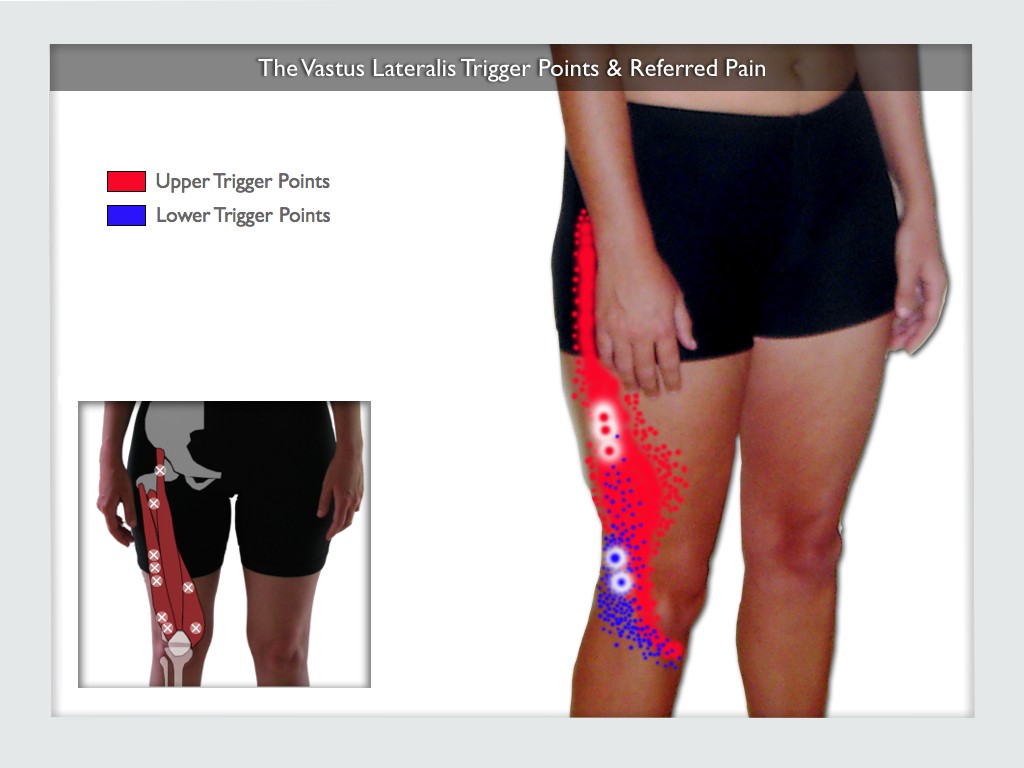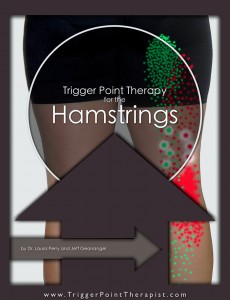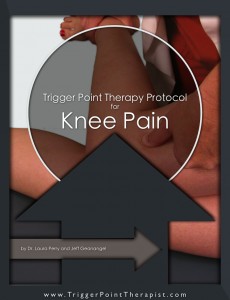The Stuck Patella Trigger Point
Trigger points in three of the four quadricep muscles are the kingpins behind many cases of knee pain and dysfunction.
 The vastus lateralis trigger points refer pain to the outside of the thigh, knee, and upper lower leg. They may also cause the “stuck patella” or “locked knee cap” conditions in which the knee cap fails to track up and down naturally during movements of the knee.
The vastus lateralis trigger points refer pain to the outside of the thigh, knee, and upper lower leg. They may also cause the “stuck patella” or “locked knee cap” conditions in which the knee cap fails to track up and down naturally during movements of the knee.
While the pain from the other quadriceps trigger points is focused only on the knee joint, the vastus lateralis trigger points may also project pain to the outside of the thigh, which may also be confused with IT Band syndrome.
The Vastus Lateralis Muscle
Location: The quadriceps femoris muscle group form the thigh musculature found on the front of the upper leg. The group is comprised of four muscles:
- The Vastus Lateralis muscle is found along the outside of the thigh.
- The Rectus Femoris muscle is found along the centerline of the thigh.
- The Vastus Medialis muscle is found along the inside of the thigh.
- The Vastus Intermedius muscle is found deep to the rectus femoris muscle along the centerline of the thigh.
Function: In everyday life, the quadricep muscle group as a whole functions to allow a person to squat, bend backwards, walk up or down stairs, and move from a standing to a seated position (or vice-versa). These muscles are not active while standing with the knees locked, but become active during the heel-strike and toe-off phases of walking.
Muscle Structure and Actions: The vastus lateralis is the largest muscle in the group. It originates along the posterior-lateral aspect of the femur bone and runs down the outside of the thigh to attach to the lateral aspect of the patella bone. Contraction of this muscle produces extension of the lower leg at the knee.
Synergistic Muscles: All of the quadricep muscles act together to produce knee extension, so the vastus lateralis muscle is assisted by the vastus medialis and rectus femoris muscles during it’s contraction. Trigger point activity can easily spread between muscles that act synergistically to produce a movement at a joint. As one muscle’s function becomes compromised by an active trigger point, the other muscles must “take up the slack”, and thus become overloaded themselves.
Antagonistic Muscles: The primary muscles that oppose the knee extension produced the quadriceps are the hamstring and gastrocnemius muscles. Contraction of the vastus medialis and vastus lateralis can exert opposing medial and lateral pulls on the patella, and must be coordinated to allow for proper patellar tracking during movement of the knee. Trigger point induced weakness in a muscle can impose abnormal neurological-reflex muscle tone in its biomechanical counterpart. This mechanism is how trigger point activity is thought to spread between antagonistic muscle groups.
The Vastus Lateralis Trigger Points and Referred Pain
There are two sets of trigger points in the vastus lateralis muscle:
- The upper vastus lateralis trigger points are located in mid-thigh region on the outside aspect of the leg. They refer pain all along the outside of the thigh and knee, from the pelvic crest down to the lower leg region just below the knee.
- The lower vastus lateralis trigger points are found just above and to the outside of the knee joint. They refer pain around the outside aspect of the knee joint and below it, sometimes extending up into the lower lateral thigh region. The pain may also be experienced as going “through the knee” and into the back of the knee, especially if it occurs in children.
What Causes Vastus Lateralis Trigger Points?
The following events or activities may activate or reactivate these quadricep trigger points:
- The quadriceps muscle group as a whole are typically overloaded by “catching oneself” after stumbling or unexpectedly stepping into a hole. In these situations the muscles undergo a strong eccentric (lengthening) contraction as they try to decelerate the body’s full weight during the fall.
- A new exercise program that includes squats or deep knee bends may also overload these muscles.
- Unaddressed trigger point activity in the hamstrings can cause chronic tightness in these muscles. As the biomechanical counterpart to the hamstrings, the quadriceps will frequently develop trigger point activity in response to the chronic muscle tension in the hamstrings.
- Clients that have tension in their soleus muscle will often compensate for this when trying to squat down and lift something by overloading their quadricep muscles. The tight soleus prevents them from flexing their ankle (dorsiflexing) properly while squatting down.
- Sitting with a leg tucked underneath the buttocks for long periods may also initiate or perpetuate trigger point activity in the vastus lateralis specifically.
- Skiing, and skiing accidents, are particularly hard on the quadricep muscles muscles in general.
- Because of its large size and prominent location on the outside of the leg, trigger points in the vastus lateralis will often occur from direct physical trauma to the thigh.
Vastus Lateralis Symptoms & Disorders
Clients with active trigger points in the vastus lateralis muscle will present with any of the following symptoms or clinical findings:
- Clients will complain of pain along the outside of the thigh and knee, that is worse when walking.
- Clients may also complain of a stuck patella that doesn’t move as it should when they try to bend or straighten the affected leg.
- In some cases, the knee may become locked with the leg in slight flexion.
- The client may walk stiff-legged with the affected leg, often dragging that foot.
Related Knee Pain Disorders
- Patellofemoral Dysfunction: This condition is characterized by abnormal tracking on the knee cap (patella) during movements of the knee joint. The contraction of the vastus lateralis and vastus medialis muscles must be coordinated properly for the patella to track normally. Trigger points in either of these muscles can compromise this coordination, causing the knee cap to be displaced laterally.
- Phantom Limb Pain: Because the pain from trigger points is typically experienced in a another region of the body, it is often responsible for phantom limb pain in people that have had a limb amputated. These people may be told that their pain is “not real” and is fabricated in their mind, but in reality their pain is as real as anyone else’s pain and has its origin in trigger points in the remaining part of the limb or trunk. Referred pain doesn’t require the body part targeted by the pain to actually exist, as it’s just a neurological reflex designed to tell the brain to modify one’s physical activity so the muscle harboring the trigger point can rest and recover.
- Nerve Entrapment: Pain on the lateral aspect of the knee may be caused by entrapment of the lateral femoral cutaneous nerves.
- Knee Joint Injury: Strains or tears of the ligaments and menisci are quite common in professional and recreational sports. As with any joint, the knee joint structures are susceptible to abnormal stress from chronic tension in the muscles that move the joint (i.e. the quadricep, hamstring, and gastrocnemius muscles). It is my opinion that many of these injuries could be avoided with some regular (maintenance) trigger point treatment to the vastus lateralis, vastus medialis, and hamstring muscles. I think this is especially true for the athletes at both ends of the conditioning spectrum (the poorly conditioned and highly conditioned athletes). Of course, many of these injuries occur from physical trauma to the leg and knee, and are thus unavoidable in the traditional sense.
- Knee Tendonitis: This condition can take place in two locations in the knee joint. Quadriceps tendonitis involves inflammation at the attachment of the vastus lateralis muscle to the patella. It entails pain along the superior and lateral border of the knee cap and is thought to be caused by chronic trigger point activity in the vastus lateralis muscle. Patellar tendonitis or “jumper’s knee” is inflammation of the patellar tendon as it runs from the bottom of the patella to its attachment on the tibia bone in the lower leg. It is not thought to have a myofascial origin or cause.
- I.T. Band Syndrome: This condition is typically seen in runners and produces pain and tenderness around the outside of the knee and lower thigh. It may be caused by trigger point activity in the tensor fascia latae, vastus lateralis (pain) and/or gluteus maximus muscles that produces excessive tension in the iliotobial tract, causing it to rub back and forth. It is typically seen in bowlegged runners or runners that have excessive wear on the lateral sole of their running shoes.
- Growing Pains: Unexplained knee and thigh pain in children is often attributed to “growing pains” when trigger point activity in the quadriceps (and other muscles) is the real cause. Children are constantly pushing their bodies to new limits and can easily overload the leg muscles while playing.
Treatment of the Quadriceps Trigger Points
Effective treatment for knee pain complaints requires the therapist to locate and release the trigger points in the vastus lateralis, rectus femoris, and vastus medialis muscles together, which is why we have included all three muscles in the Trigger Point Therapy for Quadriceps Video + 23-page PDF Booklet.
You can watch a sample from the Quadricep Trigger Points video on YouTube by clicking on the video image below:
Related Articles:
- Rectus Femoris Trigger Point: The Knee Pain Trigger Points – Part 2
- Vastus Medialis Trigger Points: The Knee Pain Trigger Points – Part 3
- The Hamstring Trigger Points: Hiding in Plain Sight
Related Instructional Videos:





